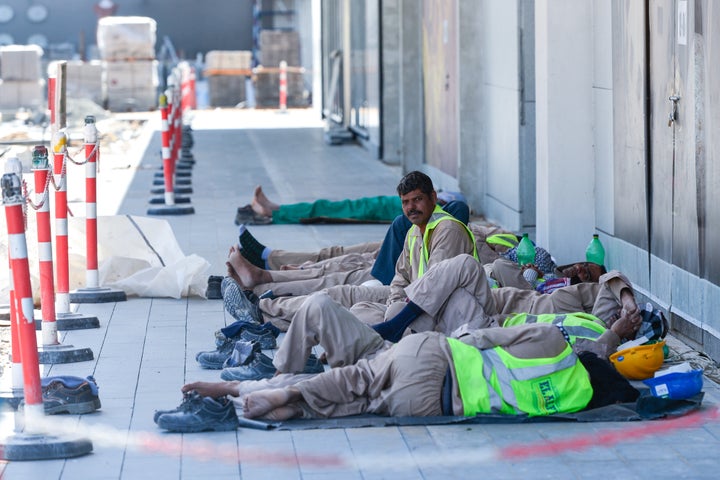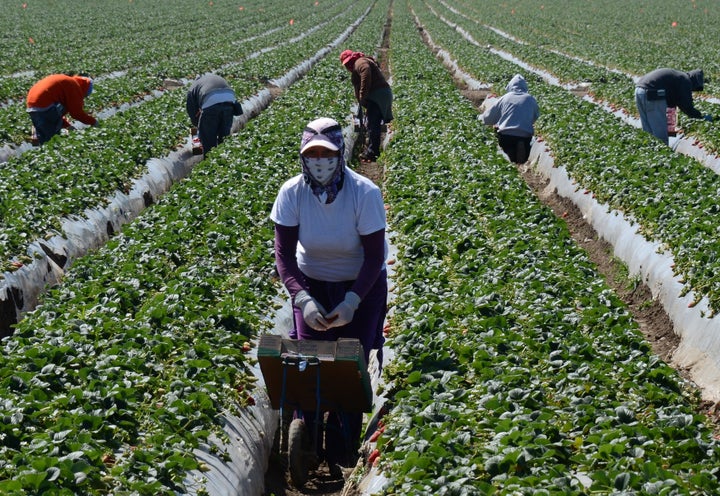On Friday, Ivanka Trump published an op-ed in The Washington Post highlighting her father’s “bold action” to combat “the evil of human trafficking.” Nearly 25 million people have been traded into human trafficking worldwide, she wrote, and her father has decided to make the issue a central feature of his domestic agenda.
Few political issues have preoccupied the White House more than human trafficking. In 2017, Trump signed an executive order calling on federal agencies to crack down on transnational criminal networks. Trump brings up trafficking at rallies and press conferences and “listening sessions.” He is the first president to attend a meeting of the Interagency Task Force to Monitor and Combat Trafficking in Persons. He declared January 2018 “National Slavery and Human Trafficking Prevention Month.”
Trump’s statements, like his daughter’s op-ed, cast human trafficking as a top-down criminal enterprise in which women and children are abducted from their home countries and brought to the U.S. against their will. “Human traffickers prey on their victims by promising a life of hope and greater opportunity, while delivering only enslavement,” Trump said a month after his inauguration. “They steal women,” he said last month, linking human trafficking to increased rates of immigration and asylum claims.
Ivanka Trump also describes human trafficking in exotic, extreme and amorphous terms, saying the phenomenon “splinters families, distorts global markets, undermines the rule of law, strengthens transnational organized criminal networks and threatens national security.”
These proclamations, however, describe a problem that bears little resemblance to the one found in academic and institutional reports. And, experts and advocates say, from what little we do know about human trafficking, the Trump administration is making it worse.

“Trafficking” isn’t what Ivanka thinks it is.
Ivanka Trump cites the International Labor Organization to claim that 24.9 million people are “victims of human trafficking, including forced labor and sex trafficking.”
This isn’t entirely accurate. While the first daughter’s op-ed identifies forced labor as a subset of human trafficking, the ILO actually uses the terms interchangeably. Everyone working under conditions of forced labor, regardless of where they are or which activity they’re engaged in, has technically been “trafficked.”
This distinction matters. The ILO’s figure of 24.9 million people refers to all victims of forced labor worldwide, few of whom are smuggled across borders and even fewer of whom are children. According to the ILO’s 2016 Global Estimates of Modern Slavery — the source for Ivanka Trump’s estimate — most trafficking victims are men and women exploited in their home countries in domestic work, agriculture and construction.
Only one-quarter of forced laborers live outside their home country and, of those, 96 percent move to countries with similar income levels. The canonical story of human trafficking is not a child sold to smugglers and taken abroad; it is a nanny forced to work long hours for low pay in the city where she was born.
“The canonical story of human trafficking is not a child sold to smugglers and taken abroad; it is a nanny forced to work long hours for low pay in the city where she was born.”
A similar broadness shows up in the figures on sex work. The ILO estimates that 4.8 million people, including 1 million children, are victims of sexual exploitation worldwide. This definition, however, includes every form of prostitution and does not distinguish between, say, teenagers kidnapped to work in brothels and adults who engage in prostitution due to poverty or unemployment.
Plus, the ILO notes that only 4 percent of victims of commercial sexual exploitation are in North or South America. The vast majority are exploited in their home countries for reasons having little to do with transnational criminal networks and everything to do with corruption, marginalization and vulnerability. A 2011 study of child sex workers in Thailand found that the overwhelming drivers of exploitation were social and economic conditions. For poor children whose parents couldn’t find work, the study concluded, “prostitution may be the best choice available.”
This doesn’t mean “human trafficking” doesn’t exist. But the phenomenon Ivanka Trump describes — people being forcibly taken across borders for work or sexual exploitation — appears to be much more isolated than her seven-digit estimate suggests.
In 2014, a nationwide database of law enforcement agencies found just 150 convictions for crimes related to bringing individuals into the United States against their will. A 2013 study found that the U.S. government had slashed its own estimates of the problem from 50,000 victims to 17,500 in just three years without explaining how the numbers were calculated in the first place. Even as Trump describes the problem as the worst it’s ever been, his own press releases note that the Department of Homeland Security identified just 500 victims of trafficking nationwide in 2017.

The Trump Administration may be making it worse.
While one problem in Ivanka Trump’s op-ed concerns the definition of trafficking, another concerns her father’s reaction to it.
The president’s only major legislative effort on the issue is passing two laws, the Allow States and Victims to Fight Online Sex Trafficking Act and the Stop Enabling Sex Traffickers Act, both of which aimed to shut down online advertisements for prostitution. While legislators justified the crackdown with calls to rescue sex workers (including using exaggerated statistics), actual sex workers have roundly criticized the laws for driving the industry underground and increasing their vulnerability.
“This bill claims to target human trafficking,” adult performer Lorelei Lee posted on Instagram, “but does so by creating new penalties for online platforms that are overwhelmingly used by consensual, adult sex workers to screen clients, to share ‘bad date lists,’ to work indoors, and to otherwise communicate with each other about ways to stay alive.”
The administration’s other anti-trafficking efforts are similarly disconnected from the evidence on the nature and scale of human trafficking. Ivanka Trump’s op-ed says countries with high trafficking rates will no longer receive foreign aid from the United States, but this declaration includes major exceptions and only affects a tiny portion of U.S. support. The president’s anti-trafficking executive order simply restates existing policy and delivers vague mandates such as “enhance cooperation with foreign counterparts.”
Other administration actions include showing an instructional video to visa applicants, despite the low likelihood that victims of trafficking or smuggling rings would apply for visas through official channels.
In nearly all of these efforts, the administration places its anti-trafficking efforts within its broader immigration policy. “As human smugglers and traffickers have learned how the game is played and how to game the system, we have witnessed a staggering 1,700 [percent] increase in asylum claims since the year 2010,” Trump said in November, equating drug and human smugglers with people applying for refugee status.
In June, then-Attorney General Jeff Sessions argued in USA Today that open border policies would encourage human trafficking. Vice President Mike Pence has made the same argument, telling a room full of Immigration and Customs Enforcement personnel that “abolishing ICE also would mean more human trafficking.”
But the links between immigration, sexual exploitation and forced labor aren’t that simple.
“In the United States, the factors leading to forced labor and sexual exploitation are the same as those abroad: structural inequality, systematic vulnerability and endemic poverty.”
“Trump’s policies are a gift to human traffickers,” Saket Soni, the executive director of the National Guestworkers Alliance, told The Guardian last year.
ICE roundups, Soni pointed out, make undocumented immigrants less likely to report forced labor conditions. Trump’s executive order cutting federal funds to sanctuary cities will make it harder for local law enforcement to investigate crimes against immigrants, including sexual exploitation. While the Department of Homeland Security and ICE claim to protect victims of trafficking from prosecution, these principles are only intermittently enforced and often result in people being deported back to countries where their risks of forced labor far exceed those in the United States.
It’s also worth remembering that the term “human trafficking” doesn’t require movement across borders. In the United States, the factors leading to forced labor and sexual exploitation are the same as those abroad: structural inequality, systematic vulnerability and endemic poverty. Half of the children released from the foster care or juvenile justice systems end up homeless within six months. More than one-quarter of teen runaways report that they’ve engaged in “survival sex” to earn money.
The most common form of forced labor in the United States takes place in agriculture, where tens of thousands of immigrants from Central America pick fruits and vegetables under conditions of debt bondage.
A 2014 study notes that even when victims are rescued from these forms of exploitation, “life post-trafficking involves the same structural vulnerabilities that enabled them to be trafficked in the first place” — namely, low-wage work, precarious housing and a ragged welfare system.
This is the more complex reality behind the imprecise, broadly defined term “human trafficking”: It is not an exotic problem in need of new approaches, but an old one that requires strengthening the systems we already have.

